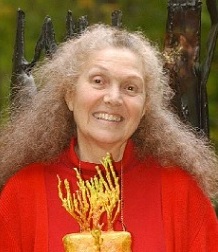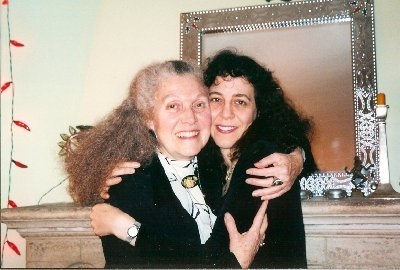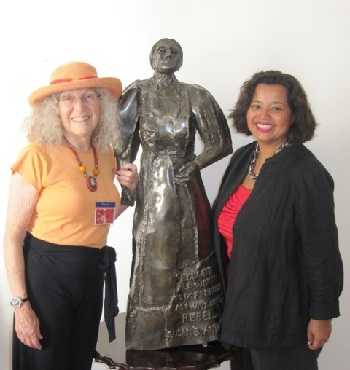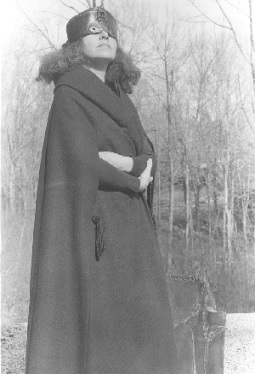SUZANNE BENTON - EARLY ACTIVIST, ARTIST, SCULPTOR, MASK MAKER, PERFORMER, A VFA FOUNDER
 I was born January 21, 1936 in Brooklyn, NY, to Florence and Alex Elkins; brother Joel had been born in March 1933. My mother started my independent life when I was three by teaching me to cross a wide street to the Prospect Park playground across from our apartment building. When I visited the neighborhood in 2008 with my daughter, we crossed that street to the park, and I felt an echo of the thrill I felt at three, proudly stepping out on my own.
I was born January 21, 1936 in Brooklyn, NY, to Florence and Alex Elkins; brother Joel had been born in March 1933. My mother started my independent life when I was three by teaching me to cross a wide street to the Prospect Park playground across from our apartment building. When I visited the neighborhood in 2008 with my daughter, we crossed that street to the park, and I felt an echo of the thrill I felt at three, proudly stepping out on my own.
I was no angel--I was a difficult child. But my harsh, unloving mother was also my best advocate. She pushed me into the world with utter equanimity, sending me for dance lessons with Pearl Primus, proponent of African dance. She bought me a piano when money was scarce and made sure I got eight years of lessons. She hadn’t finished high school but proudly saw me graduate from Queens College at 20 with a B.A. in Fine Arts.
My mother’s father, Samuel Matkoff, emigrated from Russia at 14 and immediately set to work. Still telling stories, he died at 102. Her mother, Bess, was born on the boat from Austria as it landed in New York harbor and became the family’s first American citizen. My great-grandmother, Hannah, died in childbirth when Bess was in the third grade. Taken out of school, Bess was given care of the new baby, her brothers and sisters. Uterine cancer killed her at 60, the age I was when stricken with the same disease and survived.
My father’s concern for social justice influenced me. His parents, born in the United States to Russian and Polish Jewish immigrants, owned a dairy farm in Queens, NY. He was home-schooled by his sister until their parents moved to Brooklyn. Entering public school at ten, he never adjusted to the regimen and left at 15.
As an advertising salesman for a print company he worked with the best ad agencies. But during WWII, he struggled to maintain his contacts and took a night job at a war plant in Farmingdale, NY. My family then moved to Rego Park, Queens, for his easier commute on the Long Island Railroad.
By the time I was six, our apartment building housed many who’d fled the Nazis. They’d tell nightmarish stories around our dining-room table, their faces filled with unimaginable sorrow for lost families and friends. While in Koln, Germany, in 1982-83, I created 27 masks on the theme of the Holocaust in their honor.
Friends visiting from Brooklyn told stories about “the old country,” the challenges of immigration and the labor movement. Many were committed socialists, as was my father’s sister, Regina Elkins Fruchter, a feminist, who died before I was born. My father proudly spoke of her meeting with President Woodrow Wilson at the White House to convince him to support women’s right to vote.
My best friend in high school was the boy next door, Adam Berkeley. Bright and inquisitive, he knew New York City’s cultural life. We rode the subway to Manhattan to art museums and foreign films. When I confessed to wanting to become an artist, he steered me to the Art Students League, and at 15 I studied life drawing there with Ernest Feine. I reconnected with the League in 2009 by giving a lecture and having an exhibit. I now teach a printmaking workshop there each year. One of my monoprints is in the League’s art collection and graces its president’s office.
My teen years were filled with art, piano and dance lessons, dating and working summers as a camp counselor. I loved Forest Hills High School and Queens College and at 20 became aware of the oppressive limits on women’s lives, when I was about to graduate and marry medical student Arnold Benton. He’d been taught at Downstate Medical School in Brooklyn that coitus interruptus was a means of birth control. His family’s doctor performed my illegal abortion without anesthesia. I considered the illegality of the procedure, but was not ready to have a child. I hadn’t understood the danger until five years later when another Queens College student bled to death in his office. He was prosecuted and sent to jail.
During the first two years of marriage my husband was finishing medical school and I taught art at a junior high school in Brooklyn. Pregnant women weren’t allowed to teach in NYC schools, so I hid my pregnancy with an artist’s smock, then left teaching and gave birth to my son, Daniel, in 1958. Daughter Lisa was born in 1960 but tragedy hit when she was eight months old. We hadn’t known we each carried the recessive *Tay-Sachs gene. Lisa had received one from each of us, and was condemned to become blind, never to speak, sit up or walk. This rare genetic disorder progressively destroys nerve cells in the brain and spinal cord. There is no cure. She was to die by age three.
 Despite the threat of having another Tay-Sachs baby, I tried again for a healthy child. Lisa died the night before I gave birth to Janet in 1963. Would she live, ever sit up? She was born the year The Feminist Mystique was published. Friends and I ardently read it, not yet realizing it signaled deep change in our lives and the world. Janet sat up on November 22, the day John Kennedy was assassinated. We mourned with our country as we rejoiced with our healthy baby. (photo left: Suzanne and daughter Janet.)
Despite the threat of having another Tay-Sachs baby, I tried again for a healthy child. Lisa died the night before I gave birth to Janet in 1963. Would she live, ever sit up? She was born the year The Feminist Mystique was published. Friends and I ardently read it, not yet realizing it signaled deep change in our lives and the world. Janet sat up on November 22, the day John Kennedy was assassinated. We mourned with our country as we rejoiced with our healthy baby. (photo left: Suzanne and daughter Janet.)
Still more struggle would set my activism aflame. Janet was two years old when my husband had a vasectomy. He believed himself sterile but the surgery had left a trace of sperm and I became pregnant. Abortion was still illegal in 1965. Was I to face the danger of another Tay-Sachs baby? As an exception could be made to save the life of the mother, I told three psychiatrists I would kill myself if forced to proceed with the pregnancy. The injustice and humiliation pierced my every cell. I‘d soon become a fierce feminist.
By 1965 my family had moved to Ridgefield, Connecticut. My friend Kate Kelly, trying for a divorce, was facing appalling legal constraints. We both knew we’d been stabbed by the inequities. Thinking to write a book, we began researching the position of women in America. I wrote to the Women's Bureau of the U.S Department of Labor asking for all their literature. When two large boxes arrived, I read everything, unknowingly readying to give feminist talks when the opportunity came. Asked to meet with a Connecticut Congressional Committee, I brought the list of repressive laws against women in our State and can proudly say they were repealed within a year. Ella Grasso, a congresswoman then, had organized that committee. She later became Connecticut’s first woman governor.
In 1966 Betty Friedan and 29 others founded the National Organization for Women. The NY Times magazine featured the history-making story of women joining together for change with photos of Betty, Muriel Fox, and three other founders. I had to be part of this groundbreaking movement! I wrote to Betty via the Times and received a return letter on NOW stationery with names and contact information of eight members of CT NOW.
I contacted them and we met for dinner. None shared my interest in starting a Connecticut chapter of NOW, so in 1970 I started Central Connecticut NOW. The following year, I founded and became President of Western Connecticut NOW, a chapter encompassing much of Fairfield Country. From 1973 to ‘75 I was Chairperson of Women in the Arts National Task Force for NOW, and in 1973 convener for the first Second Wave Women’s Art Festival, Women, Metamorphosis.
Consciousness-raising groups were springing up all over the country; my group included artists and writers. Our weekly sessions became the book Unmasking, edited by Valerie Harms, published by the Swallow Press of Ohio University. I became a founding member of the CT Women’s Caucus for Art and a member of the NYC chapter.
At the 1969 Eastern Regional NOW Conference, Betty Friedan had asked me to join her inner circle. Told it meant having to forego all other activities, I couldn’t give up my commitment to art and family, but would remain dedicated as a feminist activist. In her speech, Betty announced the August 26, 1970 Women's Equality Day Strike. Plans were being made all over the country, and in NYC a March down Fifth Avenue was being organized. I’d been exploring drama with my welded masks and actresses, poets and writers at feminist inter-art workshops at the Westbeth Artists Community, and my group marched, wearing my steel and bronze masks. Afterwards we gave a performance at the Village Gate for the excited post-March throng.
When Lillian Morehead ran for Ridgefield’s Board of Selectmen I opened my home studio to raise funds for her campaign with the proviso that attendees start a Women’s Political Caucus. It became an exemplary chapter that filed suit against the Boys Club for not admitting girls. We created quite a stir and won the case. The Boys and Girls Club now receives generous support from townspeople.
When it became illegal to have separate gender want ads I called the Danbury News. The editor told me the law had no teeth. I told the editor “I have teeth,” implying I would organize and harass until the paper complied. The News ceased the gender-based ads, and the Ridgefield Press complied immediately. When Title IX passed, I went to Ridgefield middle school and insisted they begin admitting girls to shop classes and boys to home economics. The Principal wondered why I was so insistent, since my daughter hadn’t yet reached middle school. I wanted the program to have been tested and working well when she’d arrive. They complied.
Many early feminists had lived in Ridgefield, including Alice Paul, who’d crafted the Equal Rights Amendment in 1923. I wanted to meet her, but she suddenly went into a nursing home and then was transferred to New Jersey, where she died in 1977.
 Ridgefield’s library had many books on women, including a two-volume biography of Susan B. Anthony. In 1974, Jacqui Ceballos, then NOW’s Eastern Regional Director, asked me to create a *papier-mâché sculpture of Anthony to be placed in Times Square (photo right). I was too busy at the time, but was inspired to later create a welded steel sculpture of Susan B.
Ridgefield’s library had many books on women, including a two-volume biography of Susan B. Anthony. In 1974, Jacqui Ceballos, then NOW’s Eastern Regional Director, asked me to create a *papier-mâché sculpture of Anthony to be placed in Times Square (photo right). I was too busy at the time, but was inspired to later create a welded steel sculpture of Susan B.
Before selling the original Susan B statue to art collector and friend David Mishkin, I made a bronze cast, which I loaned to Governor Grasso’s office in 1976-77 while I was lecturing around the world. She’d planned for it to go to the D.C. Congressional building, but died in office. The bronze was purchased by *Vivien Leone, who later donated it to the Susan B. Anthony House in Rochester, NY; Mishkin donated the original to the U.S. Embassy in Paris. I visited there in July 2013 and saw the work I’d created in 1974.
Remy Charlip, founder of Paperbag Players, was teaching Theater Arts at Sarah Lawrence College in Westchester, NY, and author-poet Ruth Krauss advised me to seek his advice. He sent a student, Judith Hannah Weiss, to work with me as her senior thesis. Emboldened, I approached the Museum of the Performing Arts at Lincoln Center to mount a show of my steel and bronze masks. Judith and I developed the mask tale Sarah and Hagar from Genesis and performed it at the opening of my Lincoln Center show in 1971. It was the first outdoor performance there. Asked to perform for the CT Congregational Church ministers wives, I became a solo performer. Bookings at many churches followed.
On November 22, 1972, I produced an evening on Broadway at the Edison Theater. Four Chosen Women featured memoirist Anais Nin, actress Vinie Burrows, dancer Joan Stone and myself performing Sarah and Hagar. The Village Voice reviewer tagged me “a young Isadora Duncan flapping her way across the stage.” The theater of 400 seats was filled to capacity. Future bookings helped me overcome my struggles as my marriage disintegrated. In 1973 I became a single mother and never let go of my vision to bring my feminist mask tales out into the world.
I met Peggy Billings, head of the United Methodists Women’s Committee, in 1973 while performing Sarah and Hagar and leading mask/story workshops at the United Methodist Women’s Quadrennial Conference in Norman, Oklahoma. David Briddell advised me to speak with her about my plan to take my work around the world. She mentored me for a year, helping with connections and arranging grant support. I learned the networking skills that made the 1976-77 world journey a success and began my life as a traveling artist.
Daniel had graduated from high school in 1976 and began Colgate College, graduating four years later Summa Cum Laude. I took Janet out of school to accompany me on the trip. She carried 27 pounds of schoolbooks, went to school in Seoul, Korea, and was tutored in Athens, Greece. When we returned to the States, she rejoined her class at Ridgefield High and graduated in three years, then on to Oberlin College, graduating in 1984.
 That year of travel I created 27 welded masks and developed Journey Tales, a series on women in Japan, Korea, India, Israel, Greece and Nigeria. I developed a workshop method that elicited the myths, histories and life stories of people throughout the world; some of these became Journey Tales. Carrying feminism worldwide, I enabled women, men, students and children to give voice to their hidden life stories. (photo left: The artist wearing Lady Macbeth steel, 10 x 8 x 6.5 inches mask).
That year of travel I created 27 welded masks and developed Journey Tales, a series on women in Japan, Korea, India, Israel, Greece and Nigeria. I developed a workshop method that elicited the myths, histories and life stories of people throughout the world; some of these became Journey Tales. Carrying feminism worldwide, I enabled women, men, students and children to give voice to their hidden life stories. (photo left: The artist wearing Lady Macbeth steel, 10 x 8 x 6.5 inches mask).
Today I continue to perform Journey Tales and 40 other mask tales. Of the over 600 masks I’ve created, 50 performance and workshop masks remain in my possession; the others are in private and public collections worldwide. From 1982 to 1984, in Koln, Germany, I created 27 masks and eight tales on the theme of the Holocaust.
Around 1990 Jacqui Ceballos interviewed me for the Schlesinger Library’s project *“The History of NOW and Betty Friedan.” Most pioneer feminists were recuperating from the marathon activity that made the Second Wave, and had not seen one another in ten years! This Schlesinger project reunited us, and *a few others I and joined Jacqui in starting Veteran Feminists of America.
A 1992 Fulbright Scholarship in Women’s Studies brought me to West Bengal, India. I made masks, developed mask tales, performed and gave lectures and workshops to people from all walks of life.
I had begun the welded-sculpture programs at Dhaka University and the art college in Chittagong in 1995, and in 2011 returned to Bangladesh and India, where I led a welding workshop for gifted students in Dhaka. In response to an unfolding tragedy, I created a mask and developed a tale about Hena Ackter, a 14-year-old girl who’d been raped, beaten, murdered, and I performed this mask tale while the events were unfolding. In Delhi, I created art at Sanskriti, an arts colony, and had an exhibition at America House. In Mumbai America House I joined with NGOs to support my workshops with community and school groups, disadvantaged women and children.
My involvement in the Women’s Movement and the changes it wrought improved my life beyond measure. It enabled my groundbreaking work and travel in 29 countries. Other defining forces include growing up in New York City, a commitment to being an artist, the death of my second child, and the joyful relief of having Janet, my disease-free third child. Of course there’s more: other men in my life, important friendships, and lovely grandchildren. I’m still planning performances and world travel, creating and selling my art, and working on a memoir. With blessings to the Women’s Movement for enabling me to live the life I wanted to lead, I continue to be propelled forward by interest and curiosity.
* Vivien Leone, an early Second Wave feminist with a special interest in women’s poetry and art, funded the women’s poetry magazine, Aphra. As a major collector of my artwork for over 20 years, she’s donated sculpture and monoprints (from my women writers, educators and feminists series) to museums and institutions.
* Mary Jean Tully headed NOW’s Legal Defense and Education Fund (today Legal Momentum) and bankrolled The History of NOW and Betty Friedan for the Schlesinger Library.
* Founders of VFA: With Jacqui Ceballos: Suzanne Benton, Gene Boyer, Noreen Connell, Janice LaRouche, Joan Michel, Irma Newmark, Mary Orovan, Barbara Rubin, Barbara Seaman, Dorothy Senerchia Elayne Snyder, Mary Jean Tully, Mary Scott Welch, Dell Williams, Sandy Zwerling.
* At the suggestion of Kate Millett I asked Lorna McNeur, a young artist, to make the papier-mâché statue. She did, and on the night of our demonstration, Lorna scuttled up the Father Duffy statue in Times Square and placed Susan B atop his head. She was arrested along with JoAnn Evansgardner and several others. --Jacqui
Contact Suzanne Benton: suzannemasks@sbcglobal.net
Suzanne Benton Website: http://www.suzannemasks.com/
Comments: Jacqui Ceballos jcvfa@aol.com